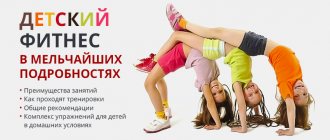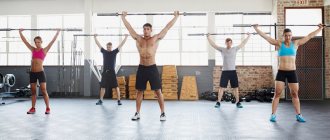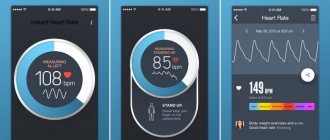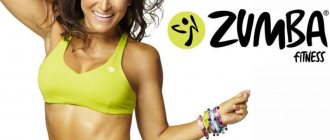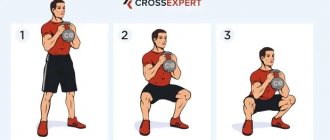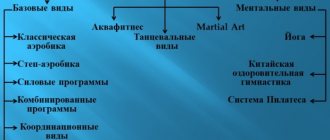Strength aerobics[edit | edit code]
Strength aerobics
Strength training is aimed at increasing muscle mass and increasing body weight in general. Aerobic training (cardio) is aimed at burning fat and reducing overall body weight. That is, these are trainings that are aimed at two directly opposite processes.
Strength aerobics
- this is a type of physical activity (training) when strength exercises are performed with weights, but at a fairly intense (aerobic) rhythm.
Let’s say that all workouts in the gym using a circular system are pure strength aerobics. There are also many special group classes that can also be called strength aerobics
. These are BODY SCULPT, POWER BALL, UPPER BODY and so on. That is, these are all workouts that are performed in the aerobics room, but with various weights and quite intensely. Body bars, expanders, fitballs, and dumbbells are used as weights in such gyms.
Thus, strength aerobics can be done both in the gym and in the aerobics room. Now let's look at all the pros and cons of this type of training.
Advantages of strength aerobics[edit | edit code]
- You can burn excess fat while maintaining muscle.
- You can gain a little muscle without increasing fat tissue
- Expend a lot of energy in a short period of time.
Disadvantages of strength aerobics[edit | edit code]
- If there are a lot of people in the gym, then performing circuit training is quite problematic.
- Not suitable for beginners. Since high intensity and the presence of weights make these workouts quite difficult.
- You can't build big muscles. Although for girls this is more of a plus than a minus.
From the pros and cons, it becomes clear who such training is most suitable for. If you already have at least a little experience in strength or aerobic training, and you do not need to lose or gain much weight, then strength aerobics is just what you need. Such training will completely help you get rid of 3 - 5 kg of fat or build up the missing 2 - 3 kg of muscle (depending on nutrition). But if you need more muscle or lose more fat, then it is better to choose either purely strength training or purely aerobic (cardio).
Whether you do strength aerobics in the gym or in group classes does not matter. It's a matter of convenience. After all, the gym allows you to do much more strength exercises. On the other hand, with a large number of people in the gym, you simply will not be able to train normally in a circle, since all the machines will be busy.
Bodybuilding and fitness - why do strength training?
Fitness and bodybuilding and health are often mutually dependent. In the conditions of modern life and various negative reasons, the constant presence in the environment of microelements that weaken human health, it is extremely important to take measures aimed at protecting the functions of one’s own body by all available methods.
This is facilitated by a balanced diet, as well as preventive measures aimed at strengthening the immune system, as well as through physical exercise. Physical exercises with weights increase functionality, improve the health of the body, increase the recovery capabilities of the body, as well as human endurance.
Strengthening muscles and joints
Thanks to bodybuilding and fitness, muscles and joints are strengthened. You need to do sports regularly, which will certainly have a positive effect on the body’s well-being and increase energy. In addition to the muscles, physical activity also strengthens various body systems: the musculoskeletal system, the cardiovascular system and the immune system.
Maintaining health is based on sports and minimal physical activity. Conversely, lack of activity negatively affects human health.
Formation of the regime
Regular fitness and bodybuilding exercises lead to the formation of a certain regimen. A regime is the daily routine with which a person feels comfortable, or, as they also say, “is in good shape.” Consequently, intense training maintains the tone of physically active people at a high level. People purposefully engage in sports and physical education for this purpose. Apart from the fact that they experience a surge of strength from the physical activity itself and enjoy it.
How do professionals differ from amateurs? Professionals, like amateurs, follow a regimen. They experience satisfaction, among other things, from physical activity. Although their loads in themselves do not pursue the goal of improving health, but primarily to win sports competitions. People who practice simply for themselves think about their health—professionals think about overcoming themselves.
For the latter, playing sports is akin to hard but beloved work. What can happen under heavy loads? Often there is a malfunction in one of the internal systems of the athlete’s body. For example, the immune system does not cope with its tasks. During the period of intensive preparation for competitions, a person is often exposed to various viruses. Excessive physical activity affects the body in the same way as a state of stress - it increases the threshold value of hormones responsible for stress, such as cortisol, which suppresses the effectiveness of immune cells.
Of course, professional athletes have increased strength and endurance in relation to ordinary people, beyond the capabilities of an ordinary person, however, the functional characteristics of the well-being of athletes must be kept under control and diagnosed.
In the end, everything is individual for each individual person. A person who thinks about his health makes his own decision about how much time he is willing to devote to sports in his life and sets priorities. If a person cares about his health and he needs to set a goal and choose a lifestyle that matches his goals, namely a healthy lifestyle. A necessary and sufficient condition for a healthy lifestyle is working out in the gym or working out.
Physical education, fitness or bodybuilding can help you keep yourself in good shape and not have problems with excess weight. As a rule, it does not matter what specific sport we are talking about; each person can choose the most suitable sport and improve their health.
Body functionality
Physical exercise improves functionality—motor physical qualities that contribute to the development of endurance, strength, and overall performance, which also contribute to achieving excellent results in many areas of activity.
The goal of bodybuilding, in particular, is hypertrophy of the body's muscular system and muscle strength, and the acquisition of endurance of the body as a whole. Playing sports by increasing performance increases the threshold of the body's functional capabilities, develops neuromuscular conductivity, motor skills and human functions.
Summarize. A rational person who sets a goal and goes towards it must thoughtfully organize his sports activities, in addition, monitor the state and level of physical strength, fatigue, follow a regimen, use sports and pharmacological means if necessary to achieve his goal, consult with specialists and more experienced athletes .
The main thing is to act, and the result will not take long to arrive! Good luck!
Strength aerobics programs[edit | edit code]
Power Ball
- strength training that uses a large ball. The goal is to work out the main muscle groups, reduce the axial load on the spine, and establish correct posture. Suitable for any fitness level.
Body Sculpt
is a type of strength training aimed at all muscle groups using special equipment (dumbbells, step platforms, body bars and other equipment). Load intensity: medium and high. Level of preparedness of students: any.
Magic Power
- an unusual workout, the purpose of which is to work out the most problematic areas, namely: thighs, abdomen, buttocks. The truly magical power of static load contributes to the acquisition of smooth outlines and perfect lines. This type of strength aerobics is also suitable for people of any fitness level.
Energy Zone
- a type of strength training that is aimed at increasing the body's endurance and polishing all muscle groups. The intensity of the lesson is high. The training is carried out in “non-stop” mode! Suitable only for people with a good level of physical fitness.
ABT
- strength training, which is aimed at training the muscles of the legs, buttocks, abdomen, i.e. lower body. Helps correct problem areas and reduce fat deposits. The training uses step platforms and weights, which helps to work the muscles of the legs, buttocks and abdomen as deeply as possible. The ABT complex also includes stretching exercises that help relieve muscle tension after strength training and restore normal breathing rhythm.
Upper Body
- a strength class, the essence of which is to work the muscles of the shoulders, arms, chest, abdominals and upper back. Suitable for any skill level.
ABS (aerobic+body+stretch)
– the lesson consists of three components: aerobic, strength and stretching. The duration of the training is one and a half hours. Optimal level of training: medium and high.
AB-Marathon
- strength training, which is aimed at working the back and abdominal muscles. Suitable for students of any level of training.
Core Training
- a one-of-a-kind activity on balance boards (barks). Aimed at training balance, strengthening the deep muscles of the body (stabilizers), developing coordination and active flexibility. Suitable for all skill levels.
Core Medical Ball
- this is the next stage after completing “Core training”. This is a core strength workout that uses a medicine ball as an additional load. Much more strength and balance!
Core Final Cuts
- strength training that uses a core platform. Helps develop balance and strengthen not only large but also small muscle groups. This activity is only suitable for people with a good level of training.
Core Barbell
- a high-intensity strength class aimed at training not only the main muscle groups, but also small muscles that are involved in the work due to the use of an unstable surface. The lesson is conducted using additional equipment: an aerobic barbell, cores and rubber shock absorbers.
Barbell Workout
— a strength lesson using additional equipment (barbells) aimed at training the main muscle groups. The lesson will be useful for both men and women with a level of preparedness starting from intermediate.
Deadly Force
- a variety of “Barbell Workout”. This is a strength class that also uses a barbell. A distinctive feature is a higher level of intensity. Recommended only for people with a good level of training.
Flexible strength
- flexible strength. The lesson is aimed at strengthening the back muscles and developing flexibility. The lesson uses slow strength work, a number of elements are taken from yoga.
Final Cuts
is a new type of strength training designed to improve body balance. It involves several muscle groups at the same time. Level of preparedness of group members: high.
Medicine Ball Training
- strength training using a medicine ball. Aimed at strengthening the muscles of the entire body and developing balance. Suitable for any skill level.
Circuit Training
— a high-intensity strength lesson, which is based on the principle of circuit training. Its main goal is to strengthen all muscle groups and develop endurance. Level of preparedness: intermediate and above.
Power Deck
— interval strength training using special platforms and rubber shock absorbers. Intensity: high.
Functional Deck
— a lesson in the format of circuit training using special platforms and additional devices, such as medicine balls and shock absorbers.
Contraindications to training
PowerClass strength training has no contraindications and is suitable for beginners who have just begun to master fitness. Even without proper preparation, knowledge of exercises and the ability to use various equipment (dumbbells, etc.), this class will not be traumatic, since the trainer pays attention to each participant.
Exceeding the permissible load on the body can lead to increased blood pressure, dizziness, nausea, vomiting, and loss of coordination. This training is also not recommended after a long illness, when the immune system is not yet ready for such stress. Strength training is also contraindicated for pregnant and lactating women, people with injuries to the spine, knees, head, pathologies of the cardiovascular system, diabetes, diseases of the veins and joints, as well as bronchial asthma.
Contraindications
Reasonable fitness is suitable for every relatively healthy person. The program is available to people with disabilities and chronic injuries, young mothers, and the elderly. No special preparation is required. The list of restrictions and contraindications includes:
- recent injuries;
- oncology;
- asthma, epilepsy;
- previous heart attacks;
- mental illness;
- serious injuries and diseases of the spine.
You should not attend classes during flu and colds, exacerbation of chronic diseases, or after surgery.
How are the training sessions going?
The basis of Mind Body is the correct balance of movement and breathing. For their perfect synchronization, concentration, concentration on each movement, and the correct rhythm of inhalation and exhalation are required. The training lasts 1-1.5 hours. The set of exercises is built from simple to complex, with each lesson the level of complexity smoothly and gradually increases.
Main stages:
- warm-up to warm up all muscle groups;
- breathing exercises;
- complex for flexibility, coordination and synchronization of movements.
The program contains up to 500 exercises, the trainer combines them, creating the most effective complex for the group or each participant. The basic elements of bodyflex, Pilates, and stretching are performed. Joint gymnastics and exercises for all parts of the spine are practiced. The classes are attractive because the movements are performed until the first feeling of fatigue, without stress, overexertion, or muscle pain. As soon as discomfort or fatigue appears, the exercise stops.
In MindBody, technique is more important than intensity and number of repetitions. Classes are usually held in small groups, the trainer sets each participant the correct technique and gives recommendations on how to achieve better results. The workouts take place at a calm pace, without serious cardio load and tension, muscles and tendons are well worked out.
The result of training using the Mind Body system:
- the heart and lungs are trained in a safe aerobic mode;
- the spine, muscles and joints are well worked out;
- tone increases, appearance improves;
- back pain and headaches go away;
- tight muscles are released;
- flexibility and strength increase, muscle corset and posture improve.
There are no exhausting workouts in Mind Body, but there is a result, and this sets it apart from other areas of fitness. After just a few weeks of classes, well-being improves, a sense of balance and awareness of movements develops, and a person understands his body better. The joints and spine become more flexible and healthy, and the need for medications decreases. Movements acquire gracefulness, like those of dancers. The development of internal muscles contributes to the efficient functioning of internal organs.
Regular exercise stimulates blood and lymph circulation, restoring oxygen metabolism in tissues. All this at the systemic level improves immunity and strengthens health.
What types of fitness are included in the complex?
- Bodyflex is a special set of aerobic breathing exercises for burning fat and developing muscles. It has a great effect on muscle tone and posture due to elements of stretching and static exercises.
- Callanetics is Pinkney Callan's gymnastics based on soft stretching, bending, half-splits, swinging, and natural breathing.
- Pilates is a system originally created for rehabilitation after severe spinal injuries. Regular training strengthens the corset muscles of the back and abdomen, helping to maintain the correct body position.
- Yoga - static exercises, stretching, rotation and bending with special breathing that saturates every organ with oxygen. Helps to relax, get rid of muscle stiffness and emotional overload.
- Tai chi is an interesting health and physical practice that builds a smart body based on elements of martial arts and dance movements.
- Qigong is an oriental set of exercises that helps achieve physical, emotional balance and purity of energy channels. The emphasis is on working the joints to maintain flexibility and youth.
- Gyrokinesis is a rhythmic wave-like exercise based on the natural movements of the spine and joints.
- The Feldenkrais method is targeted work with muscle tension, injuries, and spinal curvatures. It is based on the conscious execution of habitual movements and the search for the most effective motor balance. The technique is used by athletes and dancers.
Features of women's strength training
They are associated with the physiological characteristics of their body, objective differences between women and men:
- women are on average smaller and lighter than men;
- the hormonal structure of the female body limits the growth of muscle mass;
- the proportion of muscles in the total body weight in women is much smaller and is only 30-35% compared to 40-47% in men;
- The center of mass of the body in women is lower than in men due to the characteristics of the physique - women have a longer torso and shorter legs;
- women, due to the faster maturation of their bodies, reach their physical, including strength, standards 2-4 years faster than men;
- for women, an increase in fat deposits on the hips and buttocks (“pears”) is typical; for men, it is on the abdomen (“apples”);
- women, on average, have greater flexibility compared to men;
- women generally have a higher pain threshold (i.e., they are more “patient”) than men.
Scientific research and practical experience show that strength training, taking into account the physiological characteristics of the female body, improves health, strengthens the muscles and ligaments of the pelvic floor, and improves the figure. The musculoskeletal system of women tolerates large force loads much worse. When training, they should avoid working with extreme or close to extreme weights. Preference should be given to exercises that do not “overload” the spine, i.e., performed in a sitting or lying position. The female body tolerates loads aimed at developing endurance much better. Therefore, in training women, methods for developing strength endurance are widely used: they involve light weights, quickly reduce the fat component of body weight, and help solve problems of aesthetic correction of the physique.
To effectively solve such problems, women, like men, need to pay increased attention to the development of aerobic endurance, flexibility and coordination of movements. Currently, strength exercises in the form of rhythmic gymnastics and shaping are widespread among women. Elderly people are not recommended to get carried away with heavy weights and high volumes of load. Physical education classes at this age should be comprehensive, i.e., include, in addition to strength exercises, also exercises for aerobic (general) endurance, flexibility and coordination, with priority for exercises for general and strength endurance. Strength exercises, like women, are best performed in a sitting or lying position, so as not to overload the spine.
Intense strength training. High-intensity interval training: what is it?
First, it’s worth understanding the meaning of the term. High-intensity interval training is a relatively new system that includes active cardio exercises alternating with strength training.
The workout necessarily includes short sessions of intense cardio, which are then followed by strength exercises. Thus, the muscles are in action all the time, but the heart gets short breaks. Interval training is a kind of shock for the body. A properly selected system of exercises allows you to use completely different organ systems, which has a positive effect not only on your figure, but also on the functioning of the entire body.
Cardio and strength training for women. Debunking myths
Myth 1. All exercises are clearly divided into cardio and strength.
This is wrong. Any exercise can only conditionally be called cardio or strength. They do not exist in their pure form. And that's why:
- For aerobic exercise, the only source of energy is oxygen, but at the very beginning of its implementation you have to use muscle fuel, and this is already a strength load.
- For anaerobic exercise, oxygen is not needed at first, because muscle energy is consumed, but it lasts for no more than 12 seconds, and then the body begins to burn... oxygen, and this is already cardio.
So strength and cardio training does not exist in its pure form. Their division is based on which of the described methods of obtaining energy predominates. And here other parameters come into play - the duration and intensity of the load. For example, a regular morning run without stopping and at a constant pace is aero. But sprinting will be classified as anaerobic.
Myth 2. Cardio is for weight loss, strength training is for muscles.
And that's not true. Yes, strength training doesn't burn as many calories as cardio. But they contribute to the growth of muscle mass, and the body requires a colossal amount of energy for this. That is, with aerobic exercise, you lose weight while you do it. Anaerobic exercises allow you to use up fat reserves 24 hours a day, since muscles are formed even between classes.
If you constantly do only cardio, you can lose a little weight only in the first month of classes. Further weight loss will stop, and the breakdown of muscle mass will also begin if you do not combine them with strength loads in time.
Myth 3. Cardio is for women, strength training is for men.
This is nothing more than social prejudice. Both men and women should be able to properly combine cardio and strength training in order to achieve a beautiful, sculpted body, lose weight and improve health. Without aerial exercises, men will not be able to work on their endurance, and the heart may not be able to withstand such colossal loads. In the same way, without anaerobic exercise, girls would turn into anorexics without muscle mass, with sunken chests and skinny stringy limbs.
The conclusion suggests itself: you need to be able to combine them correctly. This will allow both men and women to get a beautiful, sculpted figure against the backdrop of good health.
Individual sessions
We are all different people, and many of us do not like to be in society, but prefer a more closed lifestyle. If you are such a person, then strength training in an individual lesson is perfect for you. A trainer will be with you throughout the training, monitoring you and giving useful instructions and advice. Exercises are performed in a specialized room. But now a new service has appeared, namely strength fitness at home.
This is a very convenient feature that saves you time. The trainer will arrive with his basic equipment and conduct the lesson. The pace and type of loads will be determined on the spot, depending on your parameters and strength capabilities.
Strength training. Strength training makes stretching worse
It is believed that strong muscles are necessarily rigid and compressed, which is why pumped-up people cannot reach the floor with their hands. In fact, the study Resistance training vs. static stretching: effects on flexibility and strength. confirmed that resistance training improves flexibility as well as static stretching.
However, strength exercises can only improve stretching if you perform them through the full range. For example, if you are doing a barbell squat, perform it until your thighs touch your shins, as in weightlifting, and not to a quarter, as some athletes do.
The same goes for upper body exercises: if you're doing a dumbbell bench press, go through the entire range of motion, stretching your chest and shoulder muscles at the bottom.

